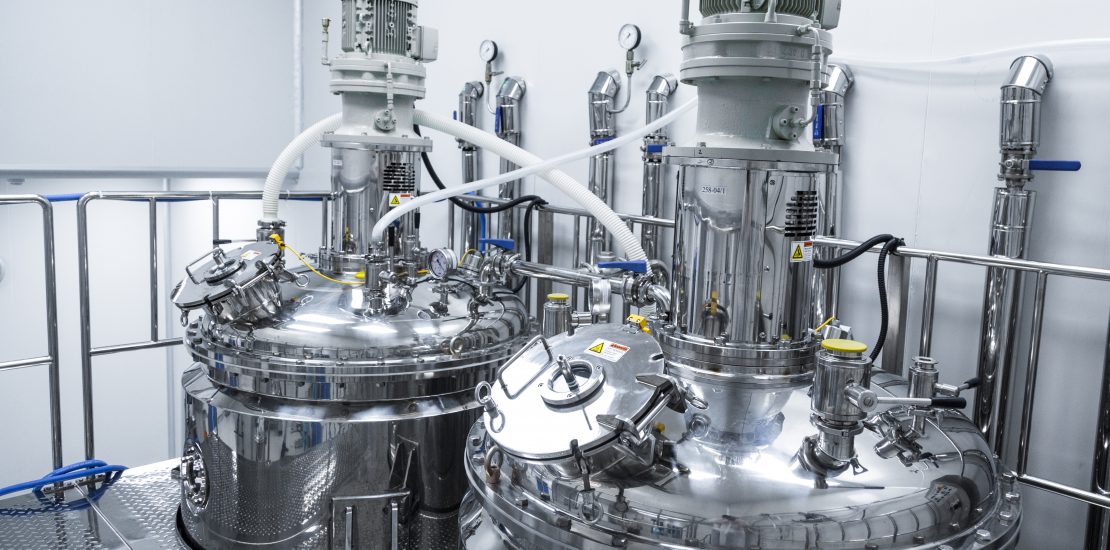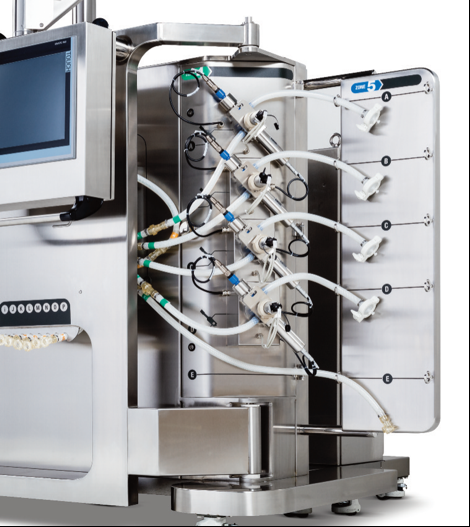- June 15, 2020
- Category: Engineering Services

Introduction
Disposable bioprocessing technologies have existed since the 1970s, originally focusing on filters and tubing sets [1]. Design options have since evolved into complex flow paths including simulated moving bed (SMB) chromatography flow kits, disposable control valves and pre-packed chromatography columns. Options, applications and creativity are bound only by the designer and their materials of choice.
Why then, have disposables not overtaken the biopharmaceutical industry as they were once projected to do? As of April 2019, disposables held approximately 15% of the market with the balance going to stainless steel (SS) [2].
Many factors have played into this, including supply chain risks, integrity issues and economics of individuals processes. Ultimately, most processes are neither fully disposable, nor designed entirely with stainless steel. Hybrid designs integrating disposables with stainless steel allow a process engineer to optimize their design using the advantages of each material.
The most economic and efficient operations will not favour an entirely disposable facility or an entirely stainless one. The optimal peak lies somewhere in between, providing designers with a vast library of options, while also reaching production faster. In 2020, an era experiencing the largest worldwide search for a single vaccine, minimizing time from design to manufacture brings an enormous humanitarian benefit.
Hybrid Integration and Design
Heavy reliance on up-front planning and design is the key to effectively integrating disposables with stainless steel equipment. There are four primary factors to consider:
- Process requirements and available technologies
- Operational impact
- Cost
- Quality
1. Process Requirements and Available Technologies
Establishment of process requirements though a User Requirement Specification provides the first filter between disposables and stainless steel. Disposable technologies have lower operating limitations for common parameters such as flow rates, volumes, temperatures and pressures.
These limitations are not absolute; custom designed disposable setups can push these boundaries. However, custom designs also carry a significant operational cost premium. Thus, designing with standard disposable designs should be pursued to minimize costs. Considering the parameters mentioned above, Table 1 outlines the general limitations experienced with standard offerings.
| Parameter | Limitation | Example/Reference |
| Temperature – Biocontainers | ≤ 60°C | ThermoFisher, Millipore, Cytiva Biocontainer Films [3]–[5] |
| Sterilization Process – Biocontainers | Gamma irradiation @ 20-45kGy for items limited below 121°C | ThermoFisher, Millipore Biocontainer Films [3], [4], [5] |
| Sterilization Process – Tubing | SIP @ < 135°C | C-Flex 374 [6] |
| Pressure (Non-reinforced Tubing) | ~ 20-30% of burst pressure | [7] |
| Pressure (Reinforced Tubing, 3/8in ID) | ≤ 5 bar | Cytiva AKTA Ready High Flow Kit [8] |
| Pressure (Reinforced Hose) | ≤ 39 bar | [7] |
| Tubing ID | ≤ 1in | ThermoFisher, Cytiva, Pall Biocontainer ports [3], [5], [9] |
| Pump Output | 267 LPM @ 4 bar | Quattroflow Diaphragm Pump Head [10] |
| Container Volume | 5000 L | [3] |
Table 1: Common process parameters with disposable limitations.
Some instances of integrating disposables with SS equipment are commonly used;
- Using disposable seed bioreactors feeding into larger, SS production bioreactors,
- Adding powdered raw materials from a bag into a SS vessel, or
- Sampling from a SS vessel or pipe into disposable sampling bags or containers.
Other instances may not be so apparent. A single unit operation may be suited to a disposable flow path, with process parameters below those outlined in Table 1. However, there may be operating limitations upstream or downstream, preventing the use of a fully disposable design. For instance, a vessel may be required for use as a collection container, feed vessel to a TFF and a holding vessel for a high temperature inactivation operation. All parameters during collection and TFF operations may be well within disposable design constraints. However, if the high temperature hold occurs above 60°C, a disposable biocontainter would not be appropriate. Inserting a SS jacketed vessel in its place would allow the process to utilize the benefits of a disposable flow path for collection and TFF operations, while also allowing the high temperature inactivation to occur without issue.
Disposables also provide opportunities for removing traditionally complex and manually intensive operations. With the rigidity of SS infrastructure, complex transfer panels or costly valve blocks are often used to redirect flow between various sources (ie. CIP or Buffer Hold farms) and end users. Each transfer panel change requires a manual intervention to switch jumpers and a proximity switch to continue the automated solution delivery. Neither the manual connection or proximity switch are entirely fool proof and can lead to costly delays in processing. The flexibility of disposable technologies allows for designing an easy to assemble manifold or header to connect sources and sinks. Depending on the design, these assemblies may also only require initial connections prior to Disposables also provide opportunities for removing traditionally complex and manually intensive operations. With the rigidity of SS infrastructure, complex transfer panels or costly valve blocks are often used to redirect flow between various sources (ie. CIP or Buffer Hold farms) and end users. Each transfer panel change requires a manual intervention to switch jumpers and a proximity switch to continue the automated solution delivery. Neither the manual connection or proximity switch are entirely fool proof and can lead to costly delays in processing. The flexibility of disposable technologies allows for designing an easy to assemble manifold or header to connect sources and sinks. Depending on the design, these assemblies may also only require initial connections prior to processing, without manual interventions during a batch. Automated valve switching ensures solution delivery to the required unit operations during processing.
2. Operational Impact
It is one thing to design a hybrid process on paper and an entirely different experience implementing such a design in the field. Therefore, it is vital to place considerable effort during the design phases to understand the technologies available. Getting hands on experience with various vendor offerings will have a tremendous benefit in selecting appropriate equipment. Collaborating with the Operations team during the design process is also imperative to a successful handover and the project conclusion.
For example, although 5000 L biocontainers are available, do they make sense to implement for a specific project? Biocontainers can be large, bulky, awkward to install and occupy a considerable amount of warehouse space.
Further, disposable instrumentation is historically less accurate than comparable SS offerings [11]; is it worth taking that risk when a SS option can provide a more reliable output? Answers to these questions come from detailed planning sessions and critical risk evaluations at the front end of design. Existing off-the-shelf vendor equipment is already integrating stainless instrumentation with disposable flow paths. Sartorius’ Cadence BioSMB unit uses a disposable flow kit which mates to reusable pH, conductivity and UV sensors on the skid outlets as shown in Figure 1

When it is determined disposables are the preferred choice, understanding how Operators will be using them will help guide the design process. Nearly all vendors will work with a designer to ensure tubing sets or biocontainers can make the desired physical connections for the unit operation. Open or dripless quick connections, sanitary tri-clamps and aseptic connectors can all be incorporated into custom biocontainer designs. Adapters between types of connections are also available if custom biocontainers do not align with a project’s cost model.
Sometimes preparatory operations do not lend themselves to disposables; Steam-in-Place (SIP) operations is a clear example of this. However, connectors are available to mate a disposable line to a SS component requiring SIP treatment. CPC provides Steam-Thru connections (Figure 2), which connect a pre-sterilized tubing set or an aseptic connector to the SS line via a sanitary tri-clamp. The SS line and tri-clamp connection are steamed through, thereby providing a sanitary flow path between the steamed line and the pre-sterilized tubing set or aseptic connector.

Consideration should also be given to campaigning with disposables for a set period of batch cycles. Performing sanitization flushes between campaign batches can be an effective method to re-use disposables, reducing operational cost pressures. Executing cleaning validation activities should be performed up front to define the number of acceptable batch re-use cycles. This is a particularly useful technique when developing a semi or fully continuous process.
Numerous tools are available to help build and design hybrid process systems. Working directly with your Operations team and understanding vendor options are key to designing an efficient and cost-effective process.
3. Cost Impact
The costs associated with selecting disposables or stainless-steel include up-front capital, raw materials, stand-alone operational (ie. dedicated CIP or autoclave cycle) and blended operational (ie. shared autoclave cycle). Table 2 below outlines the various inputs to each of these, and the comparison is not a straightforward calculation. Decisions must be made on flow path assemblies, methods of sterilization and cleaning, and overall impact to facility utilities.
| Cost Factor | Stainless Steel | Disposables |
| Up-front Capital | Vessels, skids, super-skids, etc.AutomationHigh qualification costs | Non-product contact infrastructure (skid, bag holder, etc.)AutomationLower qualification costs |
| Raw Materials | Chemicals (caustic, acid, etc.) | Tubing setsBio containersFilters; etc. |
| Stand-alone Operational | Vent filtersElectricityNatural gasChilling capacityOperator LabourThermal ValidationCleaning Validation | Autoclave and parts washer (if applicable)ElectricityNatural gas (if applicable)Operator LabourThermal Validation (if applicable)Cleaning Validation (if applicable) |
| Blended Operational | Autoclave and parts washerElectricityNatural gas | Autoclave and parts washer (if applicable)ElectricityNatural gas (if applicable) |
Table 2: Cost input overview for stainless steel and disposable components.
Pre-sterilized disposable flow paths provide the lowest level of utility impact, but highest up-front consumable cost. On-site sterilization requires thermal validation, operational labour, natural gas, and electricity consumption. Stainless steel items require routine CIP, SIP and cleaning validation efforts. All of these variables must be accounted for to establish a true cost comparison.
Developing a comprehensive costing matrix accounting for each of these parameters and the associated impact of various design options is a key tool in identifying the optimal blend of stainless steel and disposable components. Establishing this matrix early in conceptual or basic design can help alleviate the pain of various design rabbit holes by clearly identifying options which are not cost effective. This tool also provides a clear picture of the optimally costed design to steering committees and investment boards, aiding the presentation and negotiation process.
4. Quality
It would be remiss to ignore the quality implications of a hybrid design, especially in an industry typically slow to innovate and change. Much like the cost matrix for evaluating the optimal economic mix of disposables and SS components, a comprehensive risk assessment must be performed to evaluate quality impacts of disposables or SS options. Stainless steel can be beneficial early in a downstream process where risks associated with non-sterile environments are not as high. Conversely, during upstream processing or as bulk drug substance is generated, disposables begin to show comparatively reduced quality risks as sterility becomes more essential.
This risk assessment also provides an optimal platform for assessing process interventions. Different technologies lend themselves better to interventions at specific process areas. Options and mitigations which reduce quality and patient risk the most will become evident.
A business-impact risk assessment should also be performed and accounted for, to identify any areas in the process a technology may present an unacceptable business risk. For instance, is the financial risk associated with a leak in a bulk drug substance bag acceptable or not? Likewise, would cross-contamination of a re-used filling nozzle result in catastrophic product loss? A business-impact risk assessment provides these answers.
The three decision making tool outputs identified (cost matrix, quality risk assessment and business risk assessment) will likely not agree with each other at all process points. In such instances, it is important to establish a Delegation of Authority within the project to make final decisions when risk profiles and cost do not agree.
COVID-19 Considerations and Final Thoughts
With 200 treatments and 123 vaccines in development as of May 8, 2020 [12], it will be a race to the production line for any treatment proven to be effective and safe against COVID-19. Of the three project pillars (cost, quality and time), time will surely be the driver for any manufacturer to generate and release their product. To achieve this, both stainless steel and disposable technologies will play a role in such a process. Depending on location, local SS fabricators can provide vessels and skids in shorter timelines than disposable infrastructure. Similarly, existing qualified SS equipment can be repurposed and mated with standard or custom disposable flow paths to reduce time to production.
Questions around expediated QC release of disposables, or cleaning verification of repurposed SS components will need to be answered. Utilizing the best of both technological options will drive toward a revolutionary product to solve one of the greatest medical threats in our history.

Written By
Trevor Seelert
Engineering Manager
References
[1] A. G. Lopes, “Single-use in the biopharmaceutical industry: A review of current technology impact, challenges and limitations,” Food and Bioproducts Processing, vol. 93. Institution of Chemical Engineers, pp. 98–114, Jan. 01, 2015, doi: 10.1016/j.fbp.2013.12.002.
[2] I. Roizman, “Trends In Single-Use System Adoption In The Biopharma Industry,” Bioprocess Online, 2019. https://www.bioprocessonline.com/doc/trends-in-single-use-system-adoption-in-the-biopharma-industry-0001 (accessed May 04, 2020).
[3] ThermoFisher Scientific, “Single-use products and capabilities.” 2016, doi: COL03126 1116.
[4] Merck KGaA, “PureFlexTM Single-Use Process Container Films.” 2018, doi: SP1005EN00 Ver. 6.0.
[5] GE Life Sciences (Cytiva), “Single‑use mixing systems – XcellerexTM XDUO 2500 Mixer.” 2019, doi: KA6812030519DF.
[6] “C-Flex® Tubing, Formulation 374, Saint Gobain Performance | VWR.” https://ca.vwr.com/store/product/en/20093985/c-flex-tubing-formulation-374-saint-gobain-performance (accessed May 14, 2020).
[7] T. Ito, Takao; Sokolnicki, Adam; Love, “Pressure Rating for Bioprocess Single-Use Assemblies,” BioProcess International, 2016. (accessed May 06, 2020).
[8] GE Healthcare Life Sciences, “ÄKTATM ready system.” 2011, doi: 28-9159-86 AE.
[9] Pall Life Sciences, “Pall AllegroTM 3D Biocontainers and Totes.” 2010, doi: USD 2519a.
[10] QUATTROFLOW Fluid Systems, “BIOPHARMA Pumps.” 2018, doi: QTF-10100-C-03-A4.
[11] J. Markarian, “Automating Bioprocesses,” Accessed: May 13, 2020. [Online].
[12] “COVID-19 Treatment and Vaccine Tracker | Milken Institute.” https://milkeninstitute.org/covid-19-tracker (accessed May 07, 2020).

